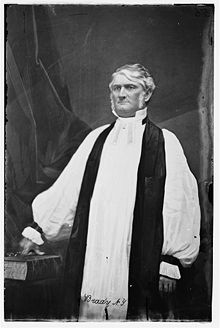 Leonidas Polk (April 10, 1806 – June 14, 1864) was a planter in Maury County, Tennessee, USA, and a second cousin of President James K. Polk. He was bishop of the Episcopal Diocese of Louisiana. He resigned his ecclesiastical position to become a major general in the Confederate army (called “Sewanee’s Fighting Bishop”). His official portrait at the University of the South depicts him dressed as a bishop with his army uniform hanging nearby.
Leonidas Polk (April 10, 1806 – June 14, 1864) was a planter in Maury County, Tennessee, USA, and a second cousin of President James K. Polk. He was bishop of the Episcopal Diocese of Louisiana. He resigned his ecclesiastical position to become a major general in the Confederate army (called “Sewanee’s Fighting Bishop”). His official portrait at the University of the South depicts him dressed as a bishop with his army uniform hanging nearby.
He is often erroneously named “Leonidas K. Polk”. He had no middle name and never signed any documents as such. The errant “K” was derived from his listing in the post-bellum New Orleans press as “Polk, Leon. (k)”, signifying “killed in action”.[citation needed]
Polk was one of the more notable, yet controversial, political generals of the war. Recognizing his indispensable familiarity with the Mississippi Valley, Confederate President Jefferson Davis commissioned his elevation to a high military position regardless of his lack of prior combat experience. He commanded troops in the Battle of Shiloh, the Battle of Perryville, the Battle of Stones River, the Tullahoma Campaign, the Battle of Chickamauga, the Chattanooga Campaign, and the Atlanta Campaign. He is remembered for his bitter disagreements with his immediate superior, the likewise-controversial General Braxton Bragg of the Army of Tennessee, and for his general lack of success in combat. While serving under the command of General Joseph E. Johnston, he was killed in action in 1864 during the Atlanta Campaign.
Atlanta Campaign and death
Polk brought more than 20,000 men with him to Georgia. Because of his elevated rank, he became the army’s second in command under Johnston. By using successive flanking maneuvers, Sherman forced Johnston to withdraw his army from strong defensive positions to protect the Confederate line of communication. This forced Johnston ever closer to the critically important city of Atlanta.[24]
On June 14, 1864, Polk was scouting enemy positions near Marietta, Georgia, with his staff when he was killed in action by a Federal 3-inch (76 mm) shell at Pine Mountain.[26] The artillery fire was initiated when Sherman spotted a cluster of Confederate generals — Polk, William J. Hardee, and Johnston, with their staffs — in an exposed area. He pointed them out to Maj. Gen. Oliver Otis Howard, commander of the IV Corps, and ordered him to fire upon them. Battery I of the 1st Ohio Light Artillery, commanded by Capt. Hubert Dilger, obeyed the order within minutes. The first round from the battery came close and a second came even closer, causing the men to disperse. The third shell struck Polk’s left arm, went through his chest, and exited hitting his right arm, then exploded against a tree; it nearly cut Polk in two.[27]
Content retrieved from: https://en.wikipedia.org/wiki/Leonidas_Polk.